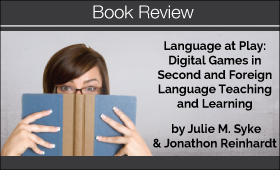Book Review: Language at Play: Digital Games in Second and Foreign Language Teaching and Learning
By Adrienne Gonzales, PhD, Foreign Language Pedagogy & Technology Specialist at University of Denver, CO.
 Language at Play: Digital Games in Second and Foreign Language Teaching and Learning by Julie M. Sykes and Jonathon Reinhardt is a volume dedicated to exploring the parallels between second language acquisition and digital game design theory, as they apply to Second Language Teaching and Learning (L2TL). The authors argue that there are five central concepts connecting these two fields: goal, interaction, feedback, context, and motivation. While their primary audience is L2TL practitioners, the text is intended to also be relevant and practical for curriculum and materials developers, administrators, researchers, and digital game developers.
Language at Play: Digital Games in Second and Foreign Language Teaching and Learning by Julie M. Sykes and Jonathon Reinhardt is a volume dedicated to exploring the parallels between second language acquisition and digital game design theory, as they apply to Second Language Teaching and Learning (L2TL). The authors argue that there are five central concepts connecting these two fields: goal, interaction, feedback, context, and motivation. While their primary audience is L2TL practitioners, the text is intended to also be relevant and practical for curriculum and materials developers, administrators, researchers, and digital game developers.
The concepts of goal, interaction, feedback, context, and motivation provide the framework for the chapters in this volume. Each chapter begins with a L2TL scenario, highlighting a conflict or issue that many L2 teachers and learners face. These scenarios are relevant and engaging, and they are followed by reflection questions that encourage thoughtful introspection to set up the theme of the chapter. Each chapter then moves on to discuss a background of the central concept at hand as it relates to L2TL. These sections, while brief, provide a solid review of L2TL principles, and they are a beneficial review of theory and research for any L2TL practitioner. The chapter then discusses its theme as it relates to digital games. These game-informed notions are useful for rethinking the aforementioned L2TL practices, and they offer a thought-provoking point of view for teachers – one that might encourage rethinking and potentially revising existing teaching methods. Reflection questions for these sections (such as “How could you incorporate game-informed feedback mechanisms–individualized, scaffolded, complex–into your classroom without the use of digital games?”) encourage thoughtful consideration about how these game-specific concepts might inform L2TL practices. After a review of the chapter topic from L2TL and gaming perspectives, each chapter presents a revised scenario, this time from a game-informed perspective. Again, these scenarios are successful in stimulating creativity and personal consideration for L2TL practitioners.
Each chapter concludes with Game-mediated applications that focus on the chapter theme. Some of the proposed activities seem designed with research in mind and centered around learners’ meta-awareness of L2TL and gaming theory. While this type of approach seems very useful for a topic-specific language course on gaming or a focus group meant to inform lesson planning and materials development, it may not be appropriate for all language courses. For the digital gaming “newbie,” this section almost poses more questions than solutions. Critical aspects such as logistical challenges, institutional limitations (the absence of a language lab on campus, for example), and the importance of creating meaningful wraparound activities are acknowledged but not discussed in sufficient detail to guide a practitioner through the process of incorporating a digital game into the curriculum. Rather than serving as a model to follow or ready-made lesson plans, these game-mediated applications might function better as examples to stimulate brainstorming.
For those new to the world of digital games, this book is an excellent introduction. It provides a number of useful tools for acquainting oneself with the basics to understand digital games and some of the culture that surrounds them. In addition to clear and informative charts and images throughout the text, the authors provide a comprehensive glossary with terms relating to both L2TL and digital games; a Guide to Game Types and Genres discussing game platforms, costs, player configurations, types, and genres; and a Digital Game Evaluation Guide for L2 Teaching and Learning to assist L2TL practitioners in identifying the specifications, tasks, goals, interactions, feedback, context and motivation and determining the value and L2TL applicability of digital games. Overall, this volume is very convincing that digital games are not only useful for L2TL, but that they can (and should) change the way we think about language teaching and learning. The difficult task of determining exactly what form this will take in classes and curricula, however, is left up to the practitioners, researchers, developers, and administrators.
For those interested in learning more about L2TL and digital games, the authors also maintain a website for their project, Games To Teach: Developing Digital Game-Mediated Foreign Language Literacies: http://games2teach.wordpress.com/.

